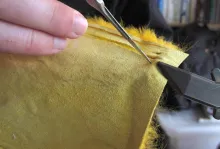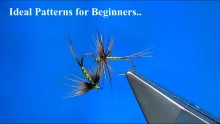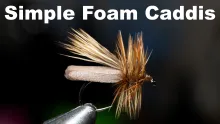In this chapter of our series we look at what to look for when buying deer hair for fly tying. Get the right material whether you are going to use it for caddis wings or for spinning bass bugs.
Deer hair is used for many types of flies, but mainly for two specific uses: wings, mainly on dry flies, and bodies and/or heads on muddler style flies and bass bugs.
The hair you want for these two applications is very different, but there's still some common things that you are looking for. Let's cover these first:
You want a flat piece of skin with consistent hair length, useful for the size of fly you are tying. Look for straight or only slightly curved hair.
You want no or as little underwool as possible. The deer grow a dense, fine and curly underwool in the winter, and when they are shot in the cold season, you will find this under the guard hairs on the skin. You will need to remove this fine wool before being able to really use the hair, stack it, spin it, flare it or whatever you want to do. The underwool will keep the guard hairs together and makes all this difficult.
On the other hand the winter hairs are the most pithy, thick and air filled, all an advantage when spinning. When using this you just have comb out the underwool. So in other words: if the hair is good, but has underwool, buy it and comb out the wool. Else go for good hair without underwool, especially on short haired skin meant for things like caddis wings, where dense hair is actually an advantage because it spins and flares less, and underwool is difficult to remove from the short hair.
You will of course - as always - be looking for clean skin and hair. Sometimes the skin has been cured and is soft, but since the hair is usually cut off the skin before it's used, even stiff, dried skin will do fine.
Look at the tips too. They need to be fine, nicely tapered and even. Look at the taper. Some hairs are equally thick with a short taper and some are tapered almost full length. If you are utilizing the taper for collars or wings, make sure that the taper is actually a length that makes sense for your use. And notice that the tapered part is usually hard and doesn't flare as well as the soft base of the hair, so using the tips of coarse hair for fine wings on small flies might not always work. Small flies typically require short hair.
Broken tips are not unusual, especially on some types of deer hair like antelope or caribou (reindeer). Again this won't matter much if you don't need the tips, but if you do, you will be very bothered by the blunt ends of the broken hairs and need to avoid skin with many broken tips.
Spinning hair
If you are looking for dyed hair to use for spinning colorful bass bugs and muddlers, some of the demands above will be hard to meet. Most dyed skin (but not all) will be crimped and curled, and the hair will follow troop and often be very messy.
This should not necessarily worry you if you just want to use the hair for spinning and trimming. A bit of steam will most likely straighten the hair, and its messiness won't be a problem once it's cut off the skin and tied in.
If you want to stack it to get even tips for collars etc., it's something completely different. In that case you want even, straight hair on nice, flat skin if at all possible. This can be found, especially in the dull color specter. If you want very bright colors or neon colors, the hair will most likely have seen some rough treatment like bleach and high temperatures, which will probably have mauled the skin beyond recognition.
Hair for wings
If you are looking for hair for wings for dry flies like the CDC&Elk, Comparadun or Elk Hair Caddis plus a large number of other flies, you are looking for short, even hair, which can be cut off in orderly bunches and stacked. You will mostly find this in skin from younger animals, often called yearlings. The length also depends on where on the animal the skin was cut. Hair from the head or legs is short while back, sides and belly has longer and coarser hair.
Opposite the spinning hair, you won't mind harder hair that won't flare as much when tying wings. Sometimes it's even a problem that the hair flares too much when you want a low profile wing.
Hand picked for this article
- Log in to post comments



















